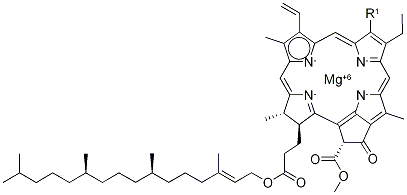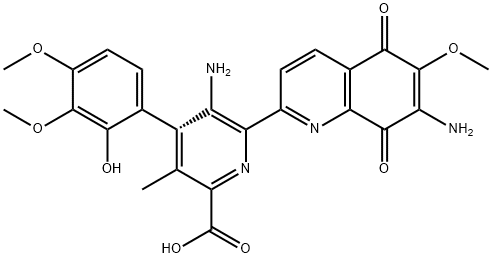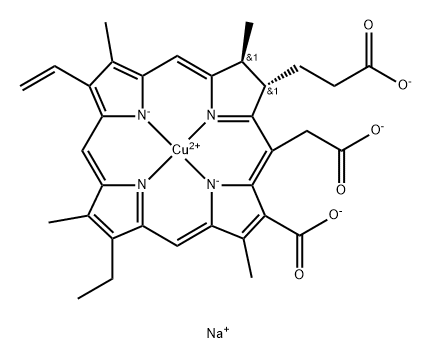CHLOROPHYLL
- CAS NO.:1406-65-1
- Empirical Formula: C54H69MgN4O5R+2
- Molecular Weight: 878.45446
- MDL number: MFCD00071051
- EINECS: 215-800-7
- SAFETY DATA SHEET (SDS)
- Update Date: 2024-12-18 14:15:30

What is CHLOROPHYLL?
The Uses of CHLOROPHYLL
Chlorophyll is a chlorin pigment found in cyanobacteria and the chloroplasts of algae and plants. Chlorophyll is an important molecule that plays a critical role in photosynthesis. Chlorophyll a is a specific form of chlorophyll used in oxygenic photosynthesis and absorbs most energy from wavelengths of violet-blue and orange-red light. Chlorophyl b is also involved in photosynthesis and absorbs primarily blue light. There are other forms of chlorophyl such as Chlorophyll c1, c2, c3 which are accessory pigments. Recently, Chlorophyll f was announced to be present in cyanobacteria and other oxygenic microorganisms that form stromatolites
The Uses of CHLOROPHYLL
chlorophyll is used as a natural coloring agent. It is credited with skin-soothing and healing properties thanks to its phytol content, and has a mild deodorizing effect. Chlorophyll is the green coloring matter found in all living plants and seen in plant leaves.
The Uses of CHLOROPHYLL
Chlorophyll is a colorant that is a green pigment present in all green plants. it is used in sausage casings, oleomargarine, and shortening.
What are the applications of Application
Chlorophyll, oil soluble is a naturally occuring pigment used for biochemical research
Definition
chlorophyll: One of a number ofpigments, including (chlorophyll aand chlorophyll b), that are responsiblefor the green colour of mostplants. Chlorophyll molecules are theprincipal sites of light absorption inthe light-dependent reactions ofphotosynthesis. They are magnesium-containing porphyrins, chemicallyrelated to cytochrome andhaemoglobin.
Agricultural Uses
Chlorophyll is a green pigment found in plants, algae and some bacteria. It is a complex chelate of magnesium containing porphyrins It is a magnesium complex of the phytil ester of porphyrin propionic acid. These pigments belong to the tetrapyrrole family of organic compounds. Genetic and environmental differences alter the relative amounts of chlorophyll pigment production and also produce leaves, ranging in color from dark green to yellow. The principal chlorophyll is chlorophyll-a , found in oxygenevolving organisms.
The leaf chlorophyll content is related to nitrogen nutrition; therefore, the relative chlorophyll content can serve as an indication of the nitrogen status of the plant. A hand-held chlorophyll meter provides an indication of the leaf nitrogen status of the crop.
Chlorophyll molecules have three functions. They serve as an antenna to absorb light quanta; they transmit this energy from one chlorophyll molecule to another by a process of 'resonance transfer' till finally the chlorophyll molecule, in close association with enzymes, undergoes chemical oxidation. The resulting electron of high potential is ejected from the molecule; this electron can then be made to perform biochemical work (that is, reduction of another compound). Thus, the energy of light quanta is converted to chemical energy.
Chlorophylls a, b, c, d and e, bacteriochlorophyll and bacterioviridin are all chlorophyll pigments. Chlorophyll-a and chlorophyll-b are abundant in higher plants. Chlorophyll-a contains a methyl group and chlorophyll-b contains an aldehyde group at C3atom.
Safety Profile
Poison by intravenous and intraperitoneal routes. When heated to decomposition it emits toxic fumes of NOx.
Properties of CHLOROPHYLL
| Merck | 14,2155 |
| EPA Substance Registry System | Chlorophyll (1406-65-1) |
Safety information for CHLOROPHYLL
Computed Descriptors for CHLOROPHYLL
CHLOROPHYLL manufacturer
Standardcon Pvt. Ltd
Vinayak Ingredients (INDIA) Pvt. Ltd.
New Products
(S)-3-Aminobutanenitrile hydrochloride 4-Methylphenylacetic acid N-Boc-D-alaninol N-BOC-D/L-ALANINOL Tert-butyl bis(2-chloroethyl)carbamate 3-Morpholino-1-(4-nitrophenyl)-5,6-dihydropyridin- 2(1H)-one Furan-2,5-Dicarboxylic Acid Tropic acid 1-Bromo-3,5-Di-Tert-Butylbenzene S-2-CHLORO PROPIONIC ACID ETHYL ISOCYANOACETATE 2-Bromo-1,3-Bis(Dimethylamino)Trimethinium Hexafluorophosphate 4-IODO BENZOIC ACID 3-NITRO-2-METHYL ANILINE 1-(2,4-DICHLOROPHENYL) ETHANAMINE (2-Hydroxyphenyl)acetonitrile 4-Bromopyrazole 2-(Cyanocyclohexyl)acetic acid 4-methoxy-3,5-dinitropyridine 1-(4-(aminomethyl)benzyl)urea hydrochloride 2-aminopropyl benzoate hydrochloride diethyl 2-(2-((tertbutoxycarbonyl)amino) ethyl)malonate tert-butyl 4- (ureidomethyl)benzylcarbamate Ethyl-2-chloro((4-methoxyphenyl)hydrazono)acetateRelated products of tetrahydrofuran








You may like
-
 1406-65-1 Chlorophyll 98%View Details
1406-65-1 Chlorophyll 98%View Details
1406-65-1 -
 1406-65-1 98%View Details
1406-65-1 98%View Details
1406-65-1 -
 Chlorophyll CAS 1406-65-1View Details
Chlorophyll CAS 1406-65-1View Details
1406-65-1 -
 1975-50-4 98%View Details
1975-50-4 98%View Details
1975-50-4 -
 2-HYDROXY BENZYL ALCOHOL 98%View Details
2-HYDROXY BENZYL ALCOHOL 98%View Details
90-01-7 -
 2-Chloro-1,3-Bis(Dimethylamino)Trimethinium Hexafluorophosphate 221615-75-4 98%View Details
2-Chloro-1,3-Bis(Dimethylamino)Trimethinium Hexafluorophosphate 221615-75-4 98%View Details
221615-75-4 -
 14714-50-2 (2-Hydroxyphenyl)acetonitrile 98+View Details
14714-50-2 (2-Hydroxyphenyl)acetonitrile 98+View Details
14714-50-2 -
 118753-70-1 98+View Details
118753-70-1 98+View Details
118753-70-1